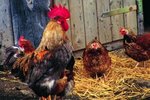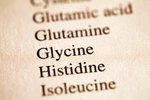
Soybeans are the second largest crop in the United States. Growing soybeans is significantly less expensive than raising livestock, and soybeans have become a popular food due to numerous health benefits. Packed with protein, they are a good alternative for those with lactose intolerance or who simply a desire to cut down on eating meat products. But humans are not alone in enjoying the benefits of soybeans.
A Little About Soy
A source of complete protein, soybeans contain all 20 amino acids, similar to eggs and red meat, but they are significantly lower in saturated fats. Originating in East Asia thousands of years ago, soybeans display quite a bit of variety -- through genetic modification, they are adapted for growth in many climates. Soybeans grow in pods; when they're mature, they're hulled and the oil is separated from protein meal through one of three pressing techniques. With approximately an 18 percent oil content, once processed, this edible product is found in many baked goods, vegetable based spreads and sauces. Eighty-five percent of soybeans become soybean oil and food products.
Soybean Meal
Once the oil is removed, the remaining solid soybean cake becomes the basis for high protein products -- especially animal feed. Soybean meal is simply ground cake that contains approximately 44 percent protein. For livestock, a soybean-based diet provides a high-quality, economical combination of proteins, fats and carbohydrates.
Livestock and Soybeans
Poultry, cattle and sheep are a significant portion of the human diet, so ensuring that they receive high-quality feed is necessary. Soybeans promote lean biomass increase in these animals, therefore improving meat quality and yield. Evidence suggests the fat content of a soybean-based diet significantly improves conception rates among cattle. Because soybean meal is a natural byproduct of oil pressing, it proves extremely economical.
Fish, Wildlife and Soybeans
Until recently, fish food for freshwater or saltwater tanks contained fish meal, essentially ground fish, as a main protein-rich ingredient. However, changes in the environment, rising fuel costs and overfishing made it necessary to find a more economical and sustainable source. Soybean meal is now a much more common source for protein in fish food. In addition, deer farmers use soybean meal to increase biomass. Unfortunately, soybean crops in the United States fall prey to significant damage by wild deer, raccoons, squirrels, groundhogs, Canada geese, and others. These animals can cause upwards of $4.5 billion in damage to soybean and corn crops annually.
References
- Alberta: Agriculture and Rural Development: US Crops - Where Are They Grown?
- National Soybean Research Laboratory: Soybean Nutrition
- University of Missouri: Feeding Whole Soybeans to Cattle
- USDA: Soybean and Oil Crops
- Purdue University: Corn and Soybean Crop Depredation by Wildlife
- Soybean Meal Info Center: Composition
- Department of Agriculture and Forestry: Soybeans for Livestock
Photo Credits
-
Jupiterimages/Creatas/Getty Images
Writer Bio
Working with both small animals and exotics, Pamela Meadors has devoted more than 15 years to the veterinary field. She possesses a bachelor's degree in biological sciences and is the proud mom of a blind hedgehog.



